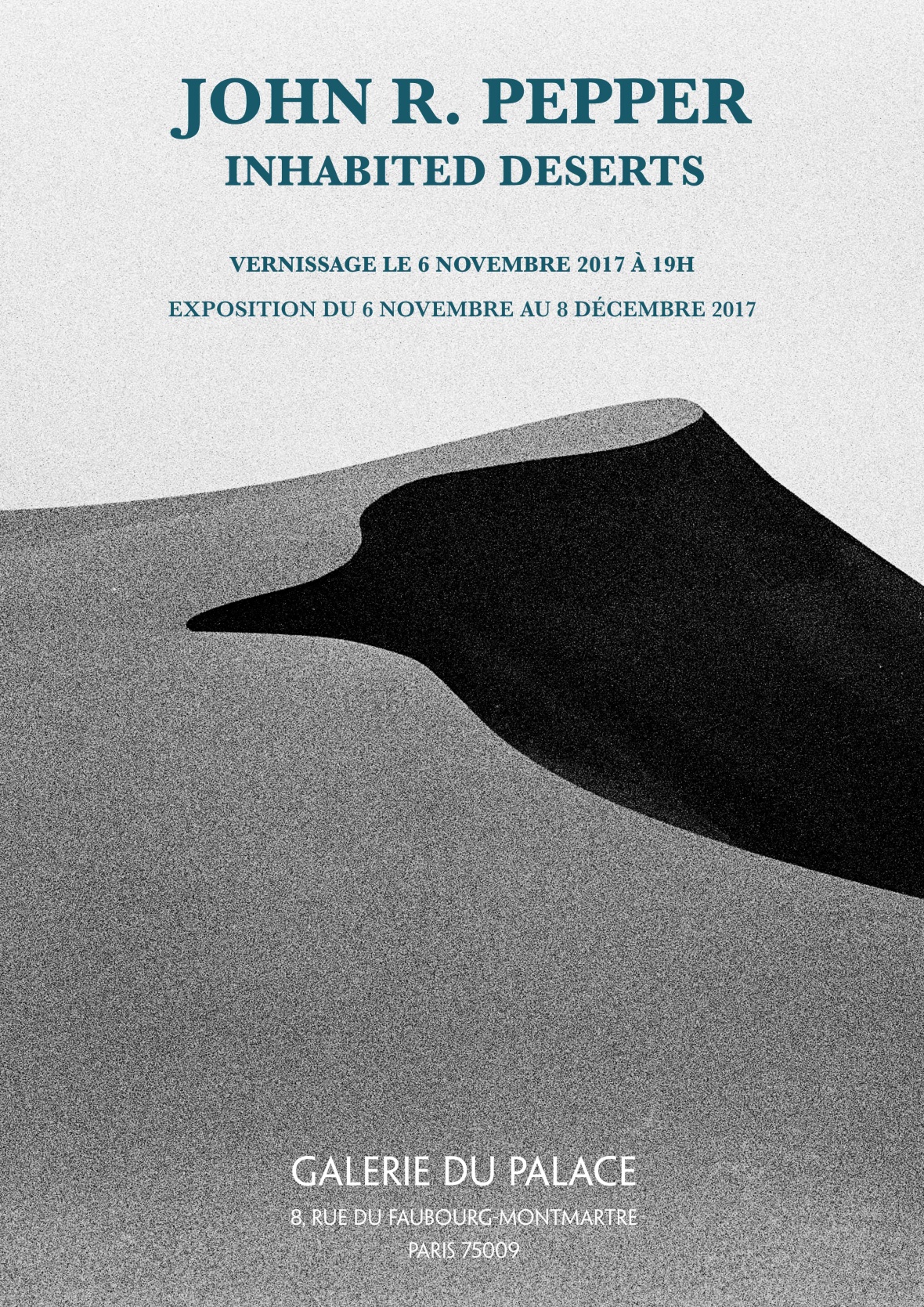'INHABITED DESERTS'
Galerie du Palace, Paris
6 November - 8 December 2017

Most people are indifferent to deserts. Deserts are "away". They are "elsewhere". They are thousands of miles away and the definition of "empty". They know deserts from their school textbooks and their associations rarely go beyond “arid, dead, mystic, frightening, mysterious, flat, hot, cold, beautiful, ugly, dangerous”. There is nothing to see there except sand and stone. And while people venture into deserts, no one actually inhabits them.
John Pepper's photographs rediscover deserts, and while going with him on this adventure, you may discover a thing or two about yourself. Even some of his legendary desert guides, men who spend their lives in the desert and know its every nook and cranny, admit they haven’t seen their own deserts like this before. And in spite of these guides, and in spite of the spirit of adventure, Pepper's deserts are not ultimately the result of travel photography. His photographs, paradoxically, don’t take you to the actual places where they are shot. They take you elsewhere, to a new place for your mind and imagination to inhabit.
What you inhabit in these photos may indeed, at the start, in a first glance, also seem arid, dead, mystic, frightening, mysterious, flat, hot, cold, beautiful, ugly, empty, dangerous, or uninhabitable. But then the mystery begins. Because as you stand before them slowly Pepper’s photographs transform what you believe you are seeing into a totally different thing. And not just one.
Some of them offer you compositions that stand out as a Nature’s monument to Earth. If a higher consciousness exists, the only reason, however illogical, to waste resources on deserts would be to build a monument to the God’s creation—that is to a planet that houses seven billion humans, in a way not dissimilar to what humans do to immortalize the best of their kind. Not surprisingly, some of the rocks look quite alive, resembling the beasts of fairytales, or divine manifestations (as in the face on a cliff), or succinctly mirroring human interactions, confrontational exchanges (as in the photo of two boulders facing each other), or dance, or a family reunion….The conflict of light and shadow, of black and white, the harmony of grey shades, the simplicity of forms and complexity of details, often turn them into powerful metaphors of the human condition—and yet they do so without a trace of human presence.
Nevertheless, people cannot be excluded from the desert universe. A few photographs in this show explore the border between the human world and the desert world. Electricity lines or the road being softly appropriated by the sand dunes offer the observer a chance to enjoy the contrast of mad-made and natural worlds, to think of the clash of human geometrical presence with the curved harmonies of desert shapes. One photograph stands out here—naked and booted footprints on a parched desert floor. It is imprinted by the man-made geometry of a shoe sole, the natural harmony of a bare foot, and the random beauty of the natural process whereby clay dries up—which may place it in the same cabinet of curiosities as the famous image of the astronaut’s boot. Though the Moon may not remember the astronaut, and the desert does seem to have memorized its visitors.
Some of the photographs invite the observer to walk into a mysterious land without domesticated animals, mobile phones or human crises. Matisse once said his art mission was to provide a mental chair for a working man. Some of Pepper’s photographs, instead of entertaining the viewer, offer a chance to get teleported into these mystical places, to roam the rocky plains, to mediate, to bury in there the stress and burnout of urban life in order to come back with new ideas, newly found calm, or just a fresh outlook on life. These photographs intend to be seductive. Fields of rhyming shades and the rhythm of lines appear so enticing that one may wonder if the images were created by an artist, rather than captured by a camera. It is at this juncture that I started seeing how the camera in Pepper’s hands becomes a brush or chisel with which he blurs the lines between capturing something already made, and creating something which has never existed.
This transition from “capture” to “create” is even more evident in the abstract or semi-abstract images --photographs of physically realistic rock and floor surfaces which emerge after a spell of looking. Abstract Expressionists struggled over the idea that their paintings could only be good if they looked “spontaneous”, not meticulously thought-out, while being clearly emotionally expressive. Pepper’s hands create abstractions that have all the expressive power of great abstraction coupled with all the spontaneity of nature. The eye cannot tire of exploring these jagged, cracked, and stained surfaces. The mind cannot get enough of the seemingly random results of millennia of elements fighting each other.
And then there are the dunes—and how by their very nature they border on the abstract and representational. For this viewer, the best way to describe the process of looking at them is to be “swimming with one’s eyes”. For indeed the eye swims through the desert swooshing along the curves of their ridges, chopping through the ripples, diving inside them; and the mind emerges from each such encounter refreshed and excited.
Who said that deserts are uninhabited? Pepper’s work populates them with our thoughts, our dreams. And any ideas they give birth to, where they entangle, give rise to something new and exciting. What is it, then, exactly, that one thinks as one looks? It’s up to you, these photos seem to say. It’s entirely up to you to take the voyage out, and linger, and decide.
KIRILL PETRIN